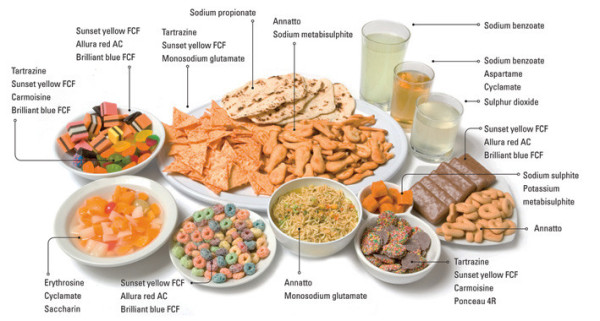Do you know what food additives are in your foods? Here’s a list of seven food additives that are banned in many foreign countries, but still used here in the U.S.
1. Artificial Food Coloring is banned in Austria, Finland, France, Norway and the U.K. In the United States you can find artificial food coloring in numerous processed foods such as cake mixes, sports drinks, cheese, candy, packaged cereals, especially those marketed to children. Food dyes add no nutritional value, they are strictly for aesthetics, to make food more appealing to the eye.
What’s the concern? Artificial dyes are linked to hyperactivity in children, asthma, brain cancer and nerve cell deterioration. Many of these dyes are petroleum based. Petroleum is used to manufacture diesel fuel, asphalt, gasoline and tar.
To read more about food coloring click here
Click here to read the 68 page report from the Center for Science in the Public Interest
2. Olestra is banned in the U.K. and Canada. Olestra, also known as Olean, is found in corn chips, French fries, and potato chips.
What’s the concern? This substitute cooking oil was created by Proctor and Gamble. The company spent a half a billion dollars developing this product. Unfortunately, it robs the body of its ability to absorb vitamins. It can also cause severe gastric distress for some individuals including severe stomach cramps and leaky bowels.
3. Brominated Vegetable Oil is banned in over 100 countries. It is found in citrus flavored sodas and. sports drinks. Adding BVO prevents the dyes from separating from the liquid and collecting at the bottom of the bottle. It is used in drinks such as Fresca Original Citrus, Gatorade, Mountain Dew ,Squirt, and, Crush to name a few.
What’s the concern? BVO is patented by chemical companies as a flame retardant. It is also banned in over 100 countries, but it is still used in the U.S. Research shows that brominated flame retardants are building up in our bodies, and are linked to birth defects, growth problems, hearing loss, major organ system damage, early onset puberty and schizophrenia. Some individuals have reacted to drinking a beverage with BVO just once, while others don’t show reactions unless they consume larger quantities. The reality is that Bromine is a fire retardant and considered an environmental toxin; it shouldn’t be in any foods or drinks. To read more about BVO click here.
4. Potassium Bromate (Bromated Flour) is banned in Canada, China and Europe. This product is frequently found in bagel chips, breads, flat breads, rolls, and wraps. It is used to speed up the commercial baking process.
What’s the concern? It is derived from the same source as BVO… petrochemicals. It is linked to cancer, kidney damage and nervous system damage. American bread manufacturers claim there is no risk, as the product disappears during the baking process. Yet in Californian, if potassium bromate is used the product must contain a warning label. While the FDA hasn’t banned this product, they do urge bakers to voluntarily leave it out.
5. Azodicarbonamide is banned in Australia, the U.K. and most European countries. Azodicarbonamide is used to bleach flour, as well as the plastics used in food packaging such as frozen food packaging, packaged baked goods, and boxed pasta mixes. It is also used in other products such as sneakers and yoga mats. How bad is it…. if you get caught using this ingredient in Singapore, you can get up to 15 years in prison and fined up to $500,000.
What’s the concern? This chemical is known to induce asthma.
6. BHA & BHT are banned in Japan, the U.K. and many European countries. BHA and BHT are used in food to prolong shelf time , developing strong odors and keep foods from becoming rancid. It is commonly used in butter, cereal, dehydrated foods, gum and meat.
What’s the concern? Hydroxyanisole (BHA) and butylated hydroxytoluene (BHT) are known to cause cancer in rats. The National Institutes of Health states that BHA & BHT are expected to be considered a carcinogen, based on the fact that it causes cancer in rats.
7. rBGH and rBST is banned in Australia, Canada, Japan, New Zealand and the EU. These GMO derived synthetic hormones are found in milk and dairy products. This growth hormone is used to increase the milk production of cows. Cows injected with these synthetic hormones become lame, infertile and develop udder infection, which in turn leads to more antibiotic use, which is passed on through the milk.
What’s the concern? First introduced by Monsanto…need I say more? The milk contains IGF-1 (insulin growth factor-1) This 70% increase in IGF-1 is easily absorbed in the body and is linked to breast, colon and prostate cancers as well as the potential for causing infertility and weakened muscle growth.
References:
Rich Food, Poor Food by Jayson Calton PhD and Mira Calton C.N.
http://www.npr.org/2011/03/30/134962888/fda-probes-link-between-food-dyes-kids-behavior
http://www.cspinet.org/reports/chemcuisine.htm
http://www.scientificamerican.com/article.cfm?id=soda-chemical-cloudy-health-history
http://www.accessdata.fda.gov/scripts/cdrh/cfdocs/cfcfr/CFRSearch.cfm?FR=180.30








